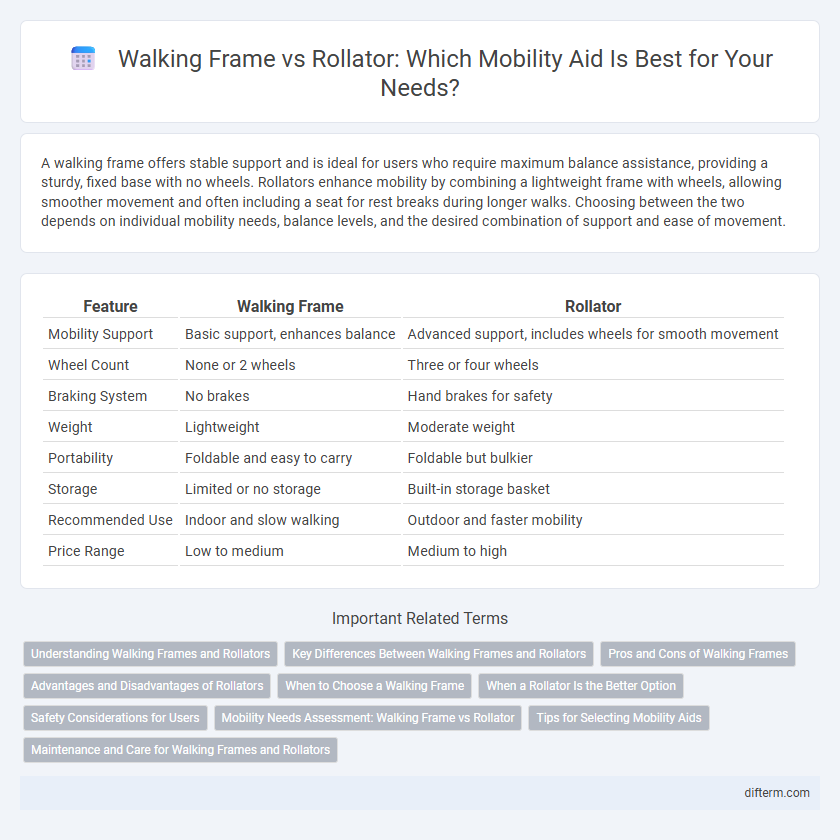A walking frame offers stable support and is ideal for users who require maximum balance assistance, providing a sturdy, fixed base with no wheels. Rollators enhance mobility by combining a lightweight frame with wheels, allowing smoother movement and often including a seat for rest breaks during longer walks. Choosing between the two depends on individual mobility needs, balance levels, and the desired combination of support and ease of movement.
Table of Comparison
| Feature | Walking Frame | Rollator |
|---|---|---|
| Mobility Support | Basic support, enhances balance | Advanced support, includes wheels for smooth movement |
| Wheel Count | None or 2 wheels | Three or four wheels |
| Braking System | No brakes | Hand brakes for safety |
| Weight | Lightweight | Moderate weight |
| Portability | Foldable and easy to carry | Foldable but bulkier |
| Storage | Limited or no storage | Built-in storage basket |
| Recommended Use | Indoor and slow walking | Outdoor and faster mobility |
| Price Range | Low to medium | Medium to high |
Understanding Walking Frames and Rollators
Walking frames provide stable support with four fixed legs and are ideal for users requiring maximum balance assistance, especially indoors. Rollators feature wheels, hand brakes, and a seat, offering enhanced maneuverability and convenience for longer distances or outdoor use. Selecting between walking frames and rollators depends on the user's mobility level, stability needs, and intended environment.
Key Differences Between Walking Frames and Rollators
Walking frames provide stable support with four fixed legs and require users to lift them for each step, making them ideal for individuals needing maximum balance assistance. Rollators feature three or four wheels, hand brakes, and built-in seats, enabling smoother mobility and rest opportunities, suitable for users with better coordination and stamina. The choice between walking frames and rollators depends on the user's balance, strength, and mobility needs.
Pros and Cons of Walking Frames
Walking frames provide enhanced stability and support for individuals with limited balance, making them ideal for those recovering from surgery or with severe mobility impairments. However, their bulky design and lack of wheels can limit speed and maneuverability, especially on uneven terrain. Unlike rollators, walking frames require users to lift the device with each step, which can be physically demanding over long distances.
Advantages and Disadvantages of Rollators
Rollators offer enhanced mobility support with built-in seats for resting during walks, adjustable handles for ergonomic comfort, and larger wheels designed to navigate various terrains easily. However, their increased weight and bulk compared to traditional walking frames can reduce portability and maneuverability in tight indoor spaces. Users also need sufficient upper body strength and coordination to control rollators safely, which may limit their suitability for individuals with severe balance or strength impairments.
When to Choose a Walking Frame
Choose a walking frame when maximum stability and support are needed, especially for individuals with severe balance issues or lower limb weakness. Walking frames provide a sturdy and stable base without wheels, making them ideal for indoor use and navigating uneven surfaces safely. They are best suited for users who require slow, deliberate movement and consistent weight-bearing assistance.
When a Rollator Is the Better Option
A rollator is the better option for individuals who require enhanced mobility support combined with convenience, as it typically features wheels, a seat, and a storage compartment. Unlike traditional walking frames, rollators allow for smoother movement over various terrains and provide users with the ability to rest easily when needed. This makes rollators particularly suitable for outdoor use and individuals with moderate balance or endurance challenges.
Safety Considerations for Users
Walking frames offer enhanced stability due to their four-point contact with the ground, reducing the risk of falls for users with limited balance. Rollators, equipped with wheels and brakes, provide greater maneuverability but require users to have sufficient hand strength and coordination to ensure safe operation. Selecting the appropriate mobility aid depends on individual safety needs, balance capabilities, and physical strength to minimize accidents and enhance user confidence.
Mobility Needs Assessment: Walking Frame vs Rollator
Mobility needs assessment is crucial when choosing between a walking frame and a rollator, as each device addresses different levels of stability and support requirements. Walking frames provide enhanced balance and support for users with significant mobility challenges or recovering from surgery, while rollators offer greater maneuverability and convenience with built-in seating for individuals who have moderate mobility impairments. Evaluating factors such as user strength, endurance, and activity level ensures optimal mobility aid selection tailored to specific functional needs.
Tips for Selecting Mobility Aids
Choosing between a walking frame and a rollator depends on individual mobility needs and stability requirements. Walking frames offer maximum support and are ideal for users needing steady balance aids, while rollators provide greater maneuverability with built-in wheels and a seat for rest. Evaluate factors like weight capacity, terrain adaptability, and user comfort to ensure optimal safety and independence.
Maintenance and Care for Walking Frames and Rollators
Walking frames require regular inspection for loose screws and worn rubber tips to ensure stability and safety, while rollators demand more frequent brake adjustments and wheel cleaning due to their complex mechanisms. Both devices benefit from routine lubrication of moving parts and prompt replacement of damaged components to maintain optimal functionality. Proper maintenance extends the lifespan of walking aids, reducing the risk of accidents and enhancing user confidence during mobility.
walking frame vs rollator Infographic

 difterm.com
difterm.com